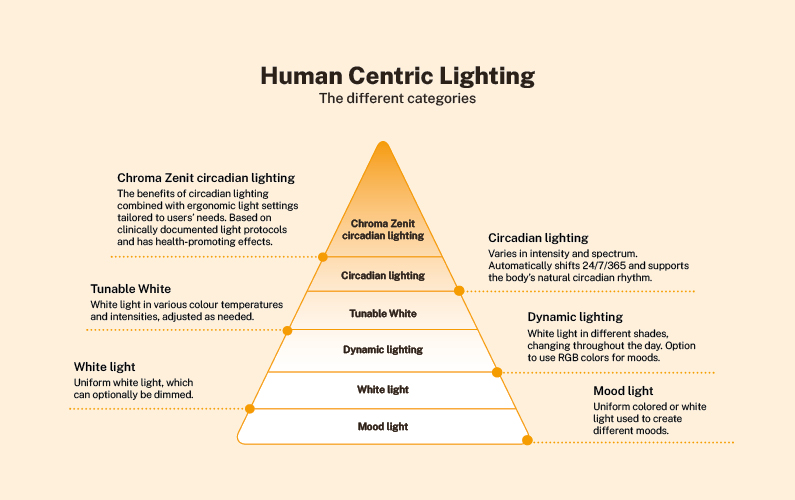The approach to Human Centric Lighting is often subject to interpretation in the lighting industry. So, how do we interpret it? And how do our lighting solutions fit into the equation? Our Chief Technology Officer, Torben, explains.
Human Centric Lighting (HCL) is an approach within lighting technology that emphasizes creating lighting environments that support human well-being and health.
HCL is a broad concept that encompasses many different types of lighting solutions. It is often open to interpretation, with some in the lighting industry associating HCL primarily with circadian lighting. While circadian lighting is indeed a key aspect of human-centric lighting, we believe that HCL goes beyond just this. Defining HCL can be challenging, as the majority of lighting solutions today can be classified under this umbrella term. So, how do we choose to interpret HCL?
Fundamentally, we believe that all lighting solutions that take into account the needs of people can be considered as Human Centric Lighting (HCL). For instance, a simple lamp with dimming functionality can easily be labelled as HCL, as it can be adjusted in intensity (brightness) based on the user's requirements. The essence of HCL lies in catering to human needs and the ability to customize a light source accordingly.
Circadian Lighting Is The Cream of The Crop
The pinnacle of HCL is lighting that replicates the natural light conditions outdoors – what we refer to as circadian lighting. The reason we place circadian lighting at the top tier when discussing HCL is that it is designed to support humans' fundamental need for circadian alignment. Human health and well-being stem from our circadian rhythm, and our entire existence relies on having a continuous light-dark cycle. Hence, one could argue that circadian lighting is the most human-centric type of lighting on the market, which is why it is often mistaken for the essence of HCL. But if circadian lighting is as "human-centric" as it gets, does that mean Human Centric Lighting equates to circadian lighting? While this connection may seem tempting and understandable, we believe the answer is no. We can delve deeper and ask: Are all types of HCL truly centred around humans?
Is The Focus On Humans Or Technology?
Taking a critical look at Human Centric Lighting (HCL), we encounter a significant issue. Currently, there is no explicit requirement for a manufacturer or supplier of HCL lighting to present evidence that the lighting solution truly is human-centred – meaning it has the desired impact on human health and well-being. In other words, it is often the technology or concept behind a lighting solution, rather than its actual effects, that earns it the label of Human Centric Lighting. As long as a lighting solution is adjustable, dynamic, or customizable to specific situations and user needs, it can be deemed as HCL in practice. This leads us to ponder: Is the focus truly on humans in HCL?
On one hand, we can answer both yes and no. The focus is on humans because the HCL approach is based on the biological fact that humans are influenced by the light they are surrounded by. HCL strives to embrace light that contributes to the health and well-being of individuals. However, on the other hand, there is a concern that HCL can sometimes ring hollow because many manufacturers and suppliers of HCL lighting do not pay attention to testing the actual impact of their lighting solutions on people. This lack of evidence raises questions about whether lighting solutions truly contribute to health and well-being, and whether they are truly centered around humans.
Are Chromaviso's Lighting Solutions Considered Human Centric Lighting?
In short, yes, our lighting solutions are considered Human Centric Lighting because we develop and design lighting with a focus on people, which is the essence of HCL. The slightly longer answer is that we co-create our lighting solutions with the people who will use them, and we base our designs on evidence. We do this with the belief that users know best, and that human-centred lighting is not truly human-centred unless its effects are tested in practice. Therefore, we ensure to test the effects of our lighting solutions through clinical studies and user surveys, so we are always certain that we are developing light that puts people at the forefront. Our lighting solutions are indeed Human Centric Lighting with clinical evidence.
Get more details about Chromaviso and our approach to lighting and HCL.


